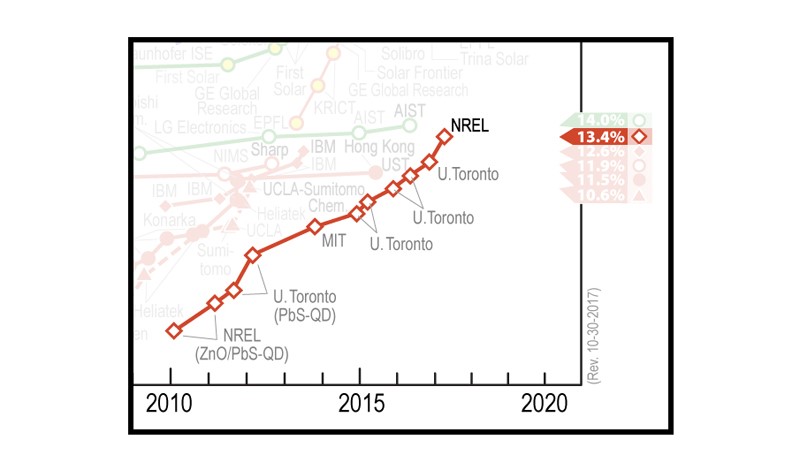
Both classes of QDs rely on the fundamental principle of confining excitons (electrons and holes) in three or fewer dimensions, which is what gives them their unique and useful optical properties. But researchers tend to focus on one or the other.
There were over 85 talks at QD2018, so it’s impossible to give you a review of everything. I have boiled it down to three highlights of active research thrusts and future QD applications of interest:
QD Lasers
Lasers are obviously an important industrial technology, and quantum dots are making a run at many of the laser-based technologies including optical communication, optical circuitry, and imaging. In fact, the company QD Laser has been doing it since 2006. One of the main benefits of their monolithic lasers is their performance at high temperatures – something that other laser types struggle with. The company does not promote its lasers for the display industry, but there is no obvious reason to think QD lasers couldn’t be used in displays in the future.
Quantum cryptography, quantum computing, QDs can act as “qbits.”

The colloidal QD community still struggles to make a good laser with colloidal QDs, but progress is being made. There were numerous talks about recent results that show we (the scientific community) are beginning to understand a bit more about what properties of a QD will impact its ability to act as a laser and how to control those properties. Still, colloidal QD lasers are a long way off.
QD Solar cells
For the past decade or so there has been intense interest in using quantum dots to make highly efficient solar cells. All solar cells are semiconductors, whether organic, inorganic, monolithic, or polycrystalline. So, it stands to reason that QDs (semiconductors themselves) could have a shot at making a good solar cell that could be fabricated using very inexpensive methods (think of painting on a QD-based ink and electrodes to make a solar cell). A good summary of the progress in this area is shown in the chart below by NREL displaying the record efficiencies of these devices over the past decade. Given that the conference was held at U. Toronto, it is fitting that many of the data points on this chart belong to that university. You can read more about the current record efficiency from perovskite QDs on my blog.

Another way to use QDs to harness the power of the sun is not as the component that converts light into electricity, but rather in the same manner that QDs are used in displays – as an optical down-converter. Two companies were represented at the conference using this technique, UbiQD and Glass to Power. The concept is called luminescent solar concentrator, and it’s been around for decades, but QDs offer inherent stability and tunability advantages over organic fluorescent dyes. The idea is to use QDs to convert UV wavelengths of light to the infrared (using QDs) and funnel those photons to the edge of a window where a smaller silicon solar cell converts them to electricity. The windows would appear mostly transparent (visible wavelengths are not harvested) and would generate electricity from the UV photons that have been converted into infrared photons. The companies are hoping that future skyscrapers will be outfitted with windows incorporating their materials.
Perovskite QDs
Again, and again at conferences in the past year, perovskites have emerged as a leading theme. Subscribers can read my review of SID Display Week 2018 for a more detailed summary of the perovskites talks related to displays (Quantum Dot Symposium Roundup – subscription required). A relative newcomer to the QD game, perovskites have shown impressive improvements in a very short time. In the academic community researchers love its simple synthesis and the rich exploration of its unique properties. Industry likes its narrow and fast emission, high quantum yields, and good absorption. Unfortunately, the same two issues persist. 1 – It contains lead, 2 – It’s unstable. The community continues to work to address these two issues.
Well, there you have it, a full week of quantum dots for breakfast, lunch, and dinner boiled down to a few highlights. Feel free to contact me if you want more info, as there was so much good science and so little space to tell you about it! – Peter Palomaki

Thanks as always for reading!
This article originally appeared on DisplayDaily.